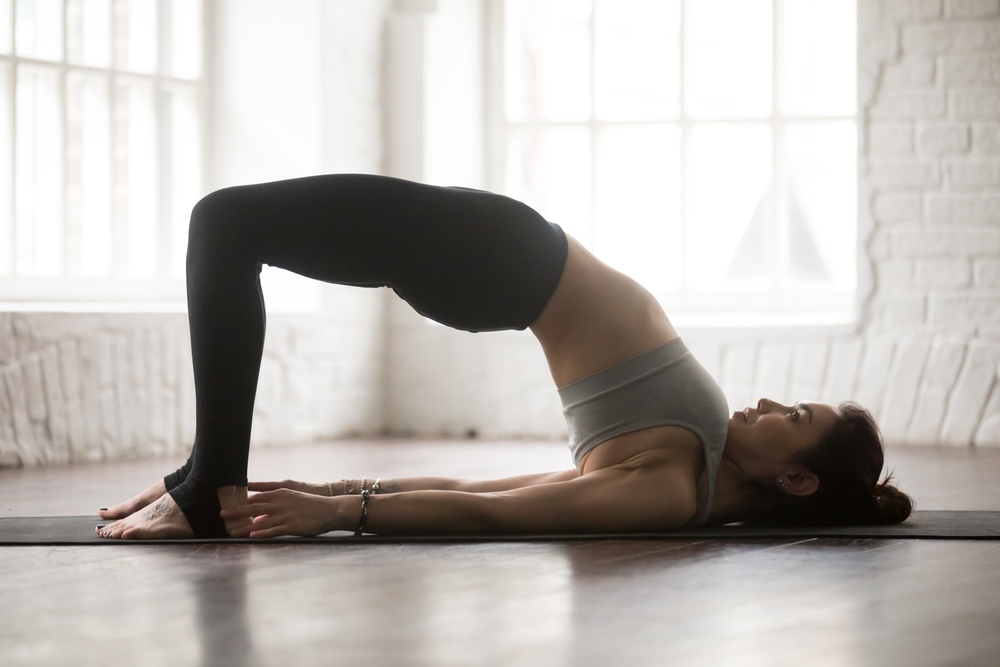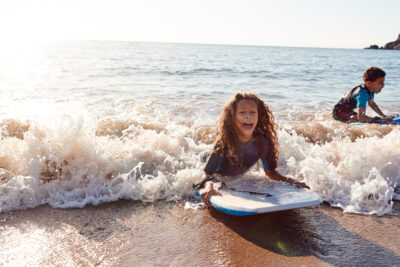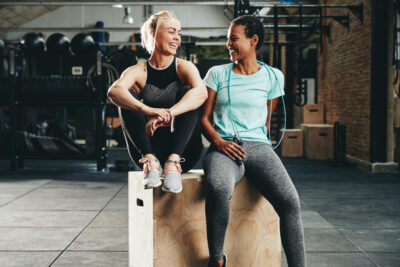Yoga teachers often refer to the feet as “the roots” of the body. It’s true; the feet ground us to the earth below us and through the ankles, to shin bones, to knee joints (and so on) above us. The feet bear the brunt of our weight as we stand—and provide the sturdy vehicles that walk, run, and climb us from place-to-place.
However, statistics from the American Podiatric Medical Association show that roughly 72-percent of Americans will suffer foot problems throughout their lifetime (i.e., plantar fasciitis, misalignment, foot ulcers, fallen arches, pinched nerves, and foot pain) because we often don’t treat our feet as the vital weight supporters they are. We squeeze them into uncomfortable shoes (and high heels), we stand on them all day long, and then we grumble about the calluses and blisters they endure, yet typically forget to pamper them unless there’s a serious issue.
Famous yoga practitioner, Rodney Yee, claims that yoga poses like these are an efficient way to “reawaken the feet” and treat all sorts of foot problems (i.e., hip misalignment and back pain) related to structural foot issues…
Mountain Pose
Many yoga practices begin with Mountain (or Tadasana) for good reason. This rooting pose simultaneously grounds us and brings awareness to how we naturally stand. Look at the wear marks on your shoes, do your feet naturally pronate (roll inward as they make contact with the ground) or supinate (roll outward as they make contact with the ground)? Mountain teaches us to distribute weight equally throughout our feet, like this:
- Standing, gently shift your weight back and forth from toes to heel.
- Now shift side to side from inner to outer sole.
- Aim to root the entire foot to the earth by connecting all edges, creating awareness of proper weight distribution.
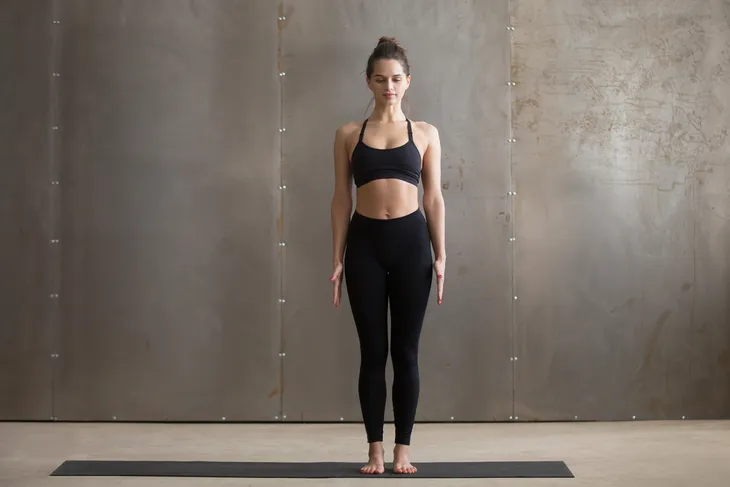
Tree Pose
Tree (or Vrksasana) aims to create a stable base while correcting the way the feet make contact with the ground below you. Equal stability—through all 4 corners of the feet (the inner and outer heels, little and big toes) can correct foot issues (tendency to roll in or out) and encourage proper ankle alignment, which can lead to back and knee issues. Tree encourages healthy weight distribution, like this:
- Take Mountain pose, feet firm.
- Bend through the right knee.
- Grasp the right ankle with your right hand.
- Place the sole of the right foot firmly against the inner left thigh/inner left groin or against the inner left calf.
- Lengthen through the tailbone—the center of your pelvis should be in a neutral position, directly over the left foot.
- Press your hands together in prayer or raise above your head, arms straight.
- Gaze softly ahead at a fixed point to aid balance.

Hero Pose
Hero pose (or Virasana) gives the entire foot a wonderful stretch—to the top of the foot and deep into the arch—to loosen tightness and encourage flexibility of the feet (and the ankles, thighs, and knees as well). If you’re a runner like I am, or you’re on your feet a lot during the day, hero will warm up your feet before and following activity and prevent plantar fasciitis, like this:
- Kneel on the floor (fold blanket to kneel on for comfort, if needed).
- Place your knees together and tops of feet flat on the floor, spread slightly wider than hip width.
- Sit back between your feet (you may want to use a block if buttocks don’t meet the floor).
- Place your hands gently in your lap.
- Focus on breathing as you lengthen the tailbone and widen the collarbone.

Eagle Pose
Eagle (or Garurasana) is an ideal way to stretch and extend the range of motion of the feet and toes. Not only does it aim to improve balance, it grounds the feet, improving circulation, lymphatic and immune function, strengthens and stretches the hips and legs, and prevents varicose veins and edema (inflammation of body tissues). To perform eagle:
- Pull navel to spine as you inhale and sit back in a squatting position.
- Squeezing through the thighs, knees together, wrap the right knee over the left, and the right foot to the calf of the left sanding leg.
- Wrap arms similarly, palms together in front of nose.
- Ground through the heel of the standing foot and stretch sole and toes so all 4 corners of the standing foot make contact with the floor.
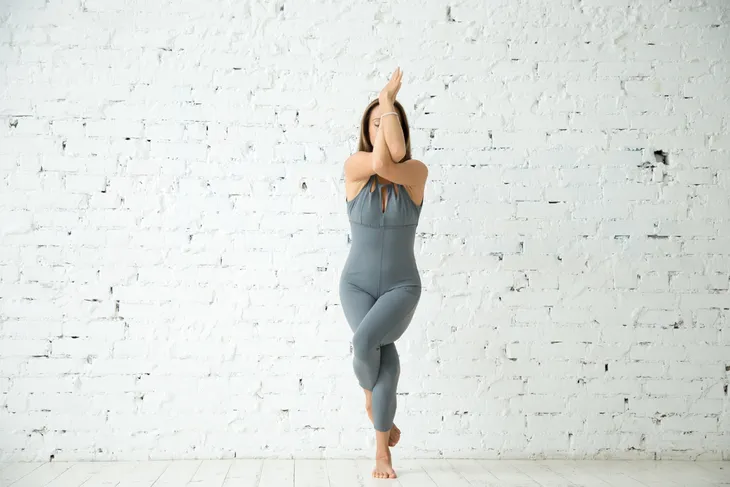
Seated Forward Bend
You might wonder why I’ve included a seated pose among stretches for foot health. However, in addition to stretching the hamstrings and entire spine, the seated forward bend (or Paschimottanasana) can offer the ideal environment to stretch your feet in a non-weight bearing pose. And, if you’re on your feet a lot and have bunions, you’re going to thank me. Perform Paschimottanasana with a block like this:
- Sit on the floor with a straight spine, legs extended and together with toes pointed at the ceiling.
- Place a yoga block flat against the soles of your feet and wrap it with a strap to simulate standing flat on the floor.
- You can roll the flesh from the sit bones to ensure a straight spine.
- Inhale and stretch your arms overhead.
- Then exhale and bend forward at the hips keeping your spine as elongated as possible and reaching towards the strap at your feet—extend the strap so you can reach comfortably while you stretch the heart towards the feet.
- Press through the toe mound into the block as you feel a nice stretch through the feet and hamstrings.
Downward Facing Dog
Downward Facing Dog (or Adho Mukha Svanasana) is a full body stretch, but it’s also another glorious way to ease tension in the feet, especially for those with plantar fasciitis, flat feet, and sciatica, as well as the back, shoulders, calves, hamstrings, hands, and foot arches. To take downward facing dog:
- Come into tabletop pose (on the hands and knees) with wrists directly below the shoulders and knees directly below your hips.
- With hands flat, spread your fingers and palms wide.
- Turn your toes under and lift your knees up (keep them loose, don’t lock).
- Lengthen through the tailbone, pressing the sit bones towards the ceiling as you
- Draw your inner thighs up into the groin and aim to ground your heels down to the floor (even if they don’t reach).
- Let the shoulder blades melt down your back and let the head and neck hang loose.

Bridge Pose
In addition to stretching the chest, neck, and spine, bridge (or Setu Bandhasana) rejuvenates the legs and feet by stretching the arches of the feet and the toes. To ensure a good foot stretch with bridge pose:
- Lie flat on the floor (supine), facing the ceiling.
- Bend your knees and set your feet on the floor at hip width with the heels positioned as close to the sit bones as possible.
- Keeping the thighs and feet parallel (above the heels), exhale and press through the feet lifting the tailbone up.
- Keeping the buttocks loose, focus on pressing up through the inner feet and the extended arms.
- Clasp the hands below your pelvis and roll onto the tops of your shoulders.
